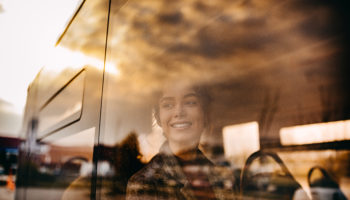In Albi, south of France, a proactive policy in favour of People with Reduced Mobility is pursued. The municipality distributes its newspaper in Braille, and since 2021 the 84,000 inhabitants of the Grand Albigeois area have been sharing a Demand-Responsive Transport (DRT) merged with a Paratransit service. Padam Mobility supported the urban area in the implementation of this merged on-demand mobility solution.
DRT? Paratransit? What are the differences?
Instead of following fixed itineraries and timetables, DRT is based on users’ bookings. Algorithms calculate rides in real time to optimise them and pool as many bookings as possible. The Paratransit is a DRT that focuses on the specific needs of the most fragile users. Often operated door-to-door, it is able to accommodate equipment such as wheelchairs and to include companions in the ride booking and management.
Why combine the two types of services?
The economic and ecological value of public transport lies in the sharing of rides. Economic, because the fuller the vehicles are, the less the rides cost the community. Ecological because sharing more rides reduces the number of kilometres travelled – particularly when empty – and emits less CO2.
While most local authorities opt for a separation of DRT and paratransit, the French region of Grand Albigeois has recognised the value of merging the services. Merging the two services means that more trips can be made. It also means that more options are offered: With a combined fleet, the local authority and users benefit from greater flexibility.
A Paratransit vehicle will no longer make an empty ride if a request from a non-Paratransit user is on its itinerary. Bringing the two offers together is also useful in fighting against the invisibility of disability. With more ride proposals and users who live alongside each other thanks to technological optimisation: the Grand Albigeois service is a success.
How do the two types of services interact?
To achieve this, the two types of service are configured simultaneously to be compatible. PRMs will be able to book their rides door-to-door, while other users will be able to book their rides stop-to-stop. This guarantees a tailor-made service for each user while maintaining the efficiency of the service. The algorithms are designed to optimise the different types of bookings, while taking into account the specific pick-up and drop-off times for PRM users who require them. To ensure a high quality of service, the local authority can choose to merge its services on a continuous basis, or over specific time slots.
In the Grand Albigeois area, the results speak for themselves: in less than 6 months, the Libé’A service has recorded 7,200 rides, 49% of which are PRM rides. The future looks even brighter for the local authority, with a 36% increase in ridership over the period of time. Many local authorities are taking a close interest in the Albi example.
Merging DRT and Paratransit: what does it mean technically?
The Padam Mobility product teams regularly look at how to merge usual public transport and Paratransit. The idea originated from many local authorities in multi-operated areas. Rather than operating two on-demand services that pool bookings separately, the aim is to obtain a merged mobility service – still adapted for Paratransit and meeting specific needs – but which is better optimised and more cost-effective, as it meets the needs of different populations simultaneously.” Samuel Bousquet, Product Manager and Javier Guimera, Transport Consultant at Padam Mobility.
The secret of the merging of DRT and Paratransit is to be found at several levels:
The algorithms
There are two types of algorithms:
- Online algorithms: used when a user makes a booking on the website or his/her mobile application. They display the booking possibilities in less than a second, and ensure that the user request and the constraints of the service are respected. This type of algorithm optimises the user’s search results to display only the most relevant information.
- Offline algorithms: these algorithms are launched outside of service hours; they aim to reduce ride times by pooling bookings for better service optimisation. For instance, this approach can change the order of rides or the distribution of vehicles.
In the context of a merged DRT and Paratransit services, these two types of algorithms will also take into account the specific needs of the users. Thus, the dwelling time – which can sometimes be longer to meet the specific needs of PRMs – or specific equipment are taken into account in a specific way in the calculation made by the algorithms.” Points out Matthieu Lormeau, Operational Research and Data Science Engineer at Padam Mobility.
The pick-up zones
In order to allow a perfect merging of DRT and Paratransit, the two services are configured to rely jointly on the same pick-up zones. The pick-up zones will coexist with stops (fixed or virtual) for DRT use, and polygons (service perimeters in which door-to-door rides are authorized for PRMs).
The allocation of services to the most suitable vehicles based on bookings
The notion of pooling and merging has a particularly important effect on the number of vehicles deployed and the economic rationality of the service. Indeed, the economic efficiency of a DRT is mainly based on the objectives of better dispatch of vehicles – or even their reduction – as well as on an objective of increasing the rate of user pooling.
Check out these articles:
How does demand responsive transport help to reduce one’s mental load?
Public Transport Demand and the built environment
How to ensure the success of your demand responsive transport (DRT) through targeted data analysis?






